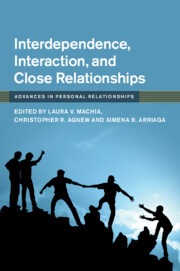Book contents
- Interdependence, Interaction, and Close Relationships
- Advances in Personal Relationships
- Interdependence, Interaction, and Close Relationships
- Copyright page
- Contents
- Figures
- Tables
- Contributors
- Acknowledgments
- Introduction
- Part I Interdependence, Situations, and Context
- Part II Interdependence, Security, and Risk
- 5 An Interdependence Analysis of Enhancing Attachment Security
- 6 Safe and Secure
- 7 Partner Buffering in Interdependent Relationships
- 8 Stress as a Risk Factor to Well-Being
- Part III Interdependence, Goal Pursuit, and Person Factors
- Part IV Interdependence, Timing, and Expectations
- Index
- References
5 - An Interdependence Analysis of Enhancing Attachment Security
from Part II - Interdependence, Security, and Risk
Published online by Cambridge University Press: 19 June 2020
- Interdependence, Interaction, and Close Relationships
- Advances in Personal Relationships
- Interdependence, Interaction, and Close Relationships
- Copyright page
- Contents
- Figures
- Tables
- Contributors
- Acknowledgments
- Introduction
- Part I Interdependence, Situations, and Context
- Part II Interdependence, Security, and Risk
- 5 An Interdependence Analysis of Enhancing Attachment Security
- 6 Safe and Secure
- 7 Partner Buffering in Interdependent Relationships
- 8 Stress as a Risk Factor to Well-Being
- Part III Interdependence, Goal Pursuit, and Person Factors
- Part IV Interdependence, Timing, and Expectations
- Index
- References
Summary
Romantic relationships affect the levels of security that people generally experience with close others. Experiences with a partner carry immediate outcomes (e.g., feeling appreciated vs. ignored), but they also can have longer lasting effects when they cause people to reflect on their overall worthiness and comfort with closeness/trust toward others. Our chapter examines how such experiences shape the mental representations that underlie chronic tendencies with attachment security, and how these representations may change with new experiences in romantic involvements. We examine change through the lens of the Attachment Security Enhancement Model, which suggests that enhancing security in relationships involves both mitigating momentary insecurity and fostering more secure mental representations over the longer term. Whether partners are effective at enhancing security may depend on the strategies they enact, and optimal strategies depend on whether a person is experiencing momentary anxiety versus avoidance. Over time, partner strategies in new situations – especially those that depart from past insecure experiences (e.g., painful interactions in close relationships) – can lead to revisions of insecure mental representations (e.g., beliefs about the self, expectations of close others). Together, using strategies to manage insecure moments and create opportunities to revise insecure mental representations may enhance security across time.
- Type
- Chapter
- Information
- Interdependence, Interaction, and Close Relationships , pp. 95 - 119Publisher: Cambridge University PressPrint publication year: 2020

